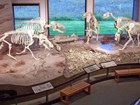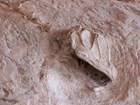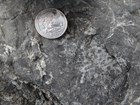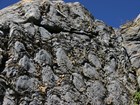The National Park System contains a magnificent record of geologic time because rocks from each period of the geologic time scale are preserved in park landscapes. The geologic time scale is divided into four large periods of time—the Cenozoic Era, Mesozoic Era, Paleozoic Era, and The Precambrian.
-
Article 1: Cenozoic Era

The Cenozoic Era (66 million years ago [MYA] through today) is the "Age of Mammals." North America’s characteristic landscapes began to develop during the Cenozoic. Birds and mammals rose in prominence after the extinction of giant reptiles. Common Cenozoic fossils include cat-like carnivores and early horses, as well as ice age woolly mammoths. Read more
-
Article 2: Mesozoic Era

The Mesozoic Era (251.9 to 66 million years ago) was the "Age of Reptiles." During the Mesozoic, Pangaea began separating into the modern continents, and the modern Rocky Mountains rose. Dinosaurs, crocodiles, and pterosaurs ruled the land and air. As climate changed and rapid plate tectonics resulted in shallow ocean basins, sea levels rose world-wide and seas expanded across the center of North America. Read more
-
Article 3: Paleozoic Era

During the Paleozoic Era (541 to 252 million years ago), fish diversified and marine organisms were very abundant. In North America, the Paleozoic is characterized by multiple advances and retreats of shallow seas and repeated continental collisions that formed the Appalachian Mountains. Common Paleozoic fossils include trilobites and cephalopods such as squid, as well as insects and ferns. The greatest mass extinction in Earth's history ended this era. Read more
-
Article 4: The Precambrian

The Precambrian was the "Age of Early Life." During the Precambrian, continents formed and our modern atmosphere developed, while early life evolved and flourished. Soft-bodied creatures like worms and jellyfish lived in the world's oceans, but the land remained barren. Common Precambrian fossils include stromatolites and similar structures, which are traces of mats of algae-like microorganisms, and microfossils of other microorganisms. Read more
